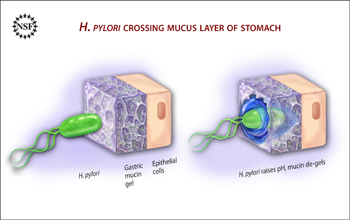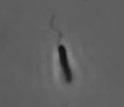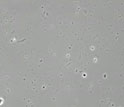News Release 09-149
Uncovering the Secrets of Ulcer-causing Bacteria
Clever biochemical strategy enables bacteria to move freely and colonize host

Heliobacter pylori liquefies stomach mucin to cross over to the epithelial cells.
August 11, 2009
View videos (clip1, clip2) showing how the bacterium that causes stomach ulcers alters its physical environment allowing it to colonize and attack cells.
This material is available primarily for archival purposes. Telephone numbers or other contact information may be out of date; please see current contact information at media contacts.
A team of researchers from Boston University, Harvard Medical School and Massachusetts Institute of Technology recently made a discovery that changes a long held paradigm about how bacteria move through soft gels. They showed that the bacterium that causes human stomach ulcers uses a clever biochemical strategy to alter the physical properties of its environment, allowing it to move and survive and further colonize its host.
The Proceedings of the National Academy of Sciences reports the findings in its most recent issue.
Helicobacter pylori is a bacterium that inhabits various areas of the stomach where it causes chronic, low-level inflammation and is linked to gastric ulcers and stomach cancer. In order to colonize the stomach, H. pylori must cope with highly acidic conditions in which other bacteria are unable to survive. It is well known however, that the bacterium accomplishes this by producing ammonia to neutralize the acid in its surroundings. In addition, newly published research shows it does something else; it changes its environment to enable freer movement.
Acidic conditions within the stomach also work against the bacteria's ability to move freely. This is due to a protein called "mucin," a crucial component of the protective mucus layer in the stomach. In the presence of acid mucin forms a protective gel, which acts as a physical barrier that stops harmful bacteria from reaching the cell wall.
But, H. pylori increases the pH of its surroundings and changes this "mucin" gel to a liquid, allowing the bacterium to swim across the mucus barrier, establish colonies, attack surface cells and form ulcers.
"Bacteria 'swim' through watery fluids using their tails to propel them," said Boston University physicist Rama Bansil, who is currently on leave from BU, working as a Division of Materials Research program manager at the National Science Foundation. "But it was not obvious how they move through a soft gel like mucus."
To answer the question Bansil, Shyam Erramilli and Jonathan Celli, also of Boston University, partnered with gastroenterologists Nezam Afdhal and Ciaran Kelly, and biochemists Sarah Keates, Bradley Turner and Ionita Ghiran at Harvard Medical School and mechanical and biomedical engineers Gareth McKinley, Peter So and Randy Ewoldt at MIT. The work began a few years ago as a feasibility study and was a part of Celli' Ph. D research.
Using video microscopes, the researchers found that when mucins extracted from mucus were in a liquid state, the bacteria could swim freely, but when mucins were in a gel state, the bacteria were stuck, even though their tails were rotating. More advanced imaging techniques revealed that pH changes directly correlated with the ability of the bacteria to move--the higher the pH, the greater the movement.
"This study indicates that the H. pylori, which is shaped very much like a screw, does not bore its way through the mucus gel like a screw through a cork as has previously been suggested," said Bansil. "Instead it achieves motility by using a clever biochemical strategy."
Researchers hope that the work will pave the way for future studies in native mucus and live animals to devise strategies for preventing H. pylori infection. Such studies could be important to the design of new therapeutic approaches that prevent the bacteria from colonizing in the first place, and also may be relevant to the broader question of bacterial infections in mucus linings in other organs.
-NSF-
-
View Video
H. pylori bacterium struggles to move in a mucin gel.
Credit and Larger Version -
View Video
H. pylori bacterium moves freely in a higher pH mucin solution.
Credit and Larger Version
Media Contacts
Bobbie Mixon, NSF, (703) 292-8485, email: bmixon@nsf.gov
Principal Investigators
Rama Bansil, Boston University, (703) 292-8562, email: rbansil@nsf.gov
Co-Investigators
Jonathan Celli, Boston University, (617) 353-2600, email: jpcelli@gmail.com
The U.S. National Science Foundation propels the nation forward by advancing fundamental research in all fields of science and engineering. NSF supports research and people by providing facilities, instruments and funding to support their ingenuity and sustain the U.S. as a global leader in research and innovation. With a fiscal year 2023 budget of $9.5 billion, NSF funds reach all 50 states through grants to nearly 2,000 colleges, universities and institutions. Each year, NSF receives more than 40,000 competitive proposals and makes about 11,000 new awards. Those awards include support for cooperative research with industry, Arctic and Antarctic research and operations, and U.S. participation in international scientific efforts.
Connect with us online
NSF website: nsf.gov
NSF News: nsf.gov/news
For News Media: nsf.gov/news/newsroom
Statistics: nsf.gov/statistics/
Awards database: nsf.gov/awardsearch/
Follow us on social
Twitter: twitter.com/NSF
Facebook: facebook.com/US.NSF
Instagram: instagram.com/nsfgov


